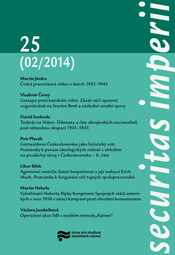Agenturní centrála Státní bezpečnosti a její vedoucí Erich Mach Poznámky k fungování sítě tajných spolupracovníků v letech 1948–1950
Agency central of the State Security and its head Erich Mach Notes on the work of the network of secret collaborators in the years 1948–1950
Author(s): Libor BílekSubject(s): Security and defense, WW II and following years (1940 - 1949), Post-War period (1950 - 1989), History of Communism
Published by: Ústav pro studium totalitních režimů
Keywords: State Security;Erich Mach;Czechoslovakia
Summary/Abstract: The study looks into the activities of the network of secret collaborators of the Czechoslovak secret political police – the State Security in the first years of the regime controlled by the communist party (1948-1950). The topic is narrated through a “story” of the so called agency central – a department which existed at the Prague headquarters of the State Security. The agency central was established in February 1948 upon the initiative of Štěpán Plaček, the head of the home intelligence. Its task was to provide assistance for other counter-intelligence departments (to carry out shadowing, detection and arrests), to control their activities and carry out extraordinary intelligence tasks. But before the agency central fully undertook its activities, its tasks had been divided due to a mass reorganization of security organs at the end of 1948. The task of the new agency central was to keep a registry of secret collaborators, assess reports obtained, submit reports on the state and development of the agency network and participate in its improvement and control. Erich Mach (1910- 1991), an ambitious and active member of the State Security, was appointed its head. He tried in vain to improve the unsatisfactorily state of the agency network – there were too few collaborators, their selection was not according to the new requirements (they were mostly active supporters of the regime who were not able to provide information about its adversaries) and the intelligence workers were not able to control them it the corresponding way due to lack of experience and clear instructions. At the beginning of 1950, the employees of the intelligence were assigned a task to make a list of important “objects” (social groups, organizations, factories, etc.) which were supposed to become sources of information. Next, they were to identify key parts through which the “objects” could be controlled and find a secret collaborator – an informer – inside. If the informer’s reports revealed that “hostile activities” were carried out in the “object”, a collaborator – agent was to be recruited, with the help of whom the hostile activity was to be revealed and eliminated. However, this system proved administratively demanding and complicated and was consequently dismissed in August 1950 even though some of its features were preserved (selection of objects and the necessity to plan penetration into the objects). In October 1950, the agency central itself was dissolved – it did not correspond to the recommendations of the Soviet advisors. A few months later (February 1951), the central registry of secret collaborators was destroyed (for fears of deconspiracy), which caused enormous problems to intelligence workers which were only done away with after it was re-established in 1954. Owing to its extent, the study is divided into two parts; the second part will be published in the next issue of this journal.
Journal: Securitas imperii
- Issue Year: 2014
- Issue No: 25
- Page Range: 132-182
- Page Count: 51
- Language: Czech

